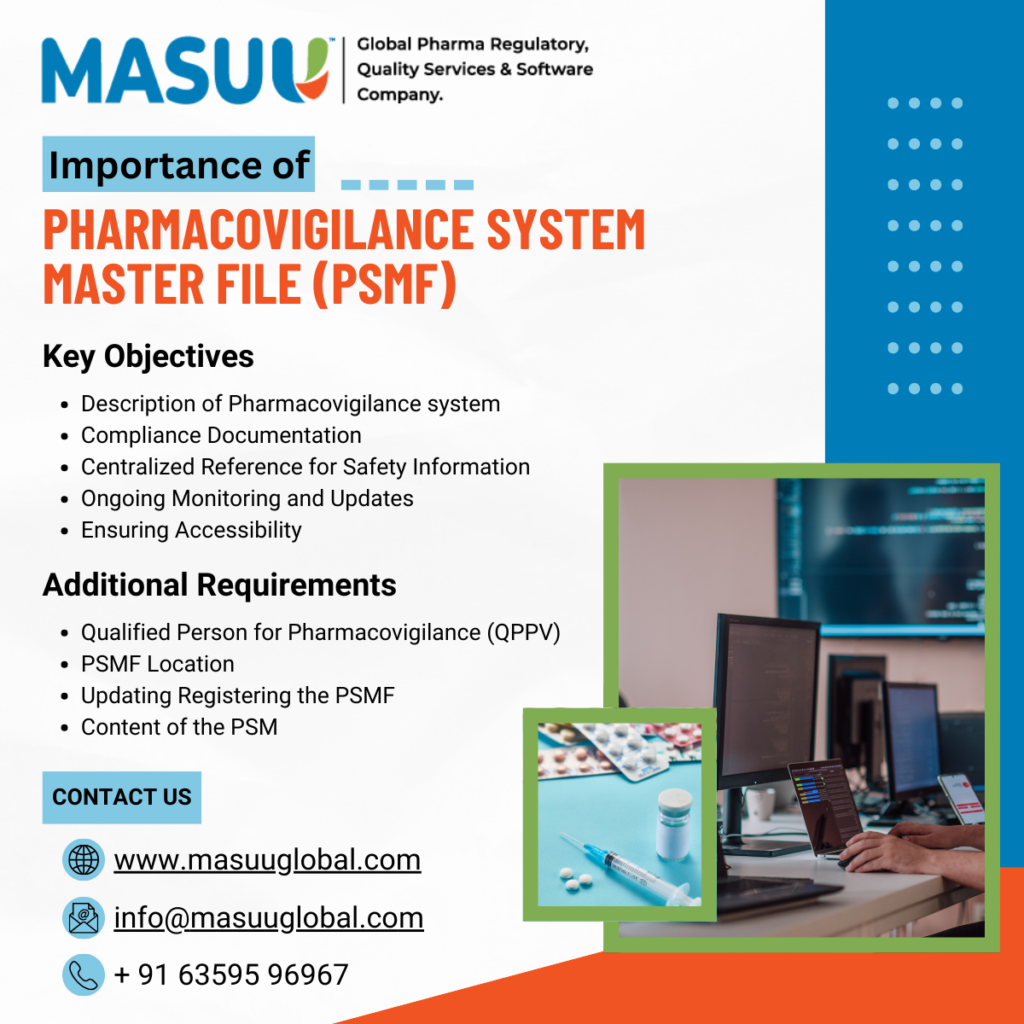The Pharmacovigilance System Master File (PSMF) is a key regulatory requirement under the EU pharmacovigilance legislation, ensuring that medicinal products authorized in the European Union (EU) comply with the stringent safety monitoring and reporting standards. Its primary objective is to provide a detailed description of the pharmacovigilance (PV) system in place, documenting the structure, processes, and the responsibilities of stakeholders involved in drug safety.

- Description of the Pharmacovigilance System: The PSMF should provide a clear and comprehensive description of the pharmacovigilance system used for medicinal products authorized within the EU. This includes all the systems applied at global, regional, and local levels, ensuring the collection, evaluation, and reporting of safety data globally, while complying with local regulatory requirements in the EU.
- Compliance Documentation: The PSMF must document the pharmacovigilance system’s compliance with the regulatory requirements of the EU and other applicable markets. It serves as proof to competent authorities that the marketing authorization holder (MAH) has established and maintains an effective pharmacovigilance system.
- Centralized Reference for Safety Information: It acts as a centralized file for all safety data related to medicinal products, which can be accessed by regulatory authorities, such as the European Medicines Agency (EMA) or national competent authorities, for evaluation during marketing authorization application processes and post-authorization periods.
- Ongoing Monitoring and Updates: The PSMF must be regularly updated to reflect changes in the pharmacovigilance system. It is a dynamic document that evolves to account for new pharmacovigilance practices, regulatory changes, new safety data, and changes in the system, such as transfers of responsibility or outsourcing of activities.
- Ensuring Accessibility: The PSMF should be easily accessible to the Qualified Person for Pharmacovigilance (QPPV), ensuring they have up-to-date and accurate information about the safety system. It must also be available for inspection at the location where it is kept, either in a paper-based or electronic format, and the location of the PSMF should be publicly available via the European medicines web-portal for transparency.
- Qualified Person for Pharmacovigilance (QPPV): The PSMF must include detailed information about the QPPV, including their responsibilities, contact details, and the location where they perform their duties. It must also ensure that the QPPV is responsible for overseeing the entire pharmacovigilance system and is in a position to make improvements to it.
- PSMF Location: The PSMF must be kept within the EU or within countries that are part of the European Economic Area (EEA) like Norway, Iceland, or Liechtenstein. If the main pharmacovigilance activities take place outside the EU, the location should default to the site where the QPPV operates.
- Updating and Registering the PSMF: The location and other information about the PSMF must be registered in the Article 57 database. Changes such as updates to the QPPV or location of the PSMF should be communicated and updated in the database within 30 days of the change to ensure continuous regulatory oversight.
- Content of the PSMF: The PSMF should include several sections, such as:
- A description of the pharmacovigilance system.
- Information on the qualified person responsible for pharmacovigilance (QPPV).
- Details about sources of safety data.
- Information on computerized systems and databases used in pharmacovigilance.
- A section on pharmacovigilance processes.
- An overview of the performance of the pharmacovigilance system.
- Details of the quality system in place.
If the marketing authorization holder decides to transfer pharmacovigilance responsibilities, this must be clearly documented. Any significant changes in the pharmacovigilance system or its master file, including updates after audits or inspections, should be communicated promptly to the QPPV. Additionally, if a contract QPPV is involved, the marketing authorization holder must ensure the proper delegation and oversight.
Conclusion:The PSMF is crucial in ensuring that pharmacovigilance practices are robust, compliant with EU regulations, and effectively protect public health by maintaining a strong system for monitoring the safety of medicinal products. The document provides transparency, maintains oversight, and supports regulatory authorities in assessing the compliance and quality of the pharmacovigilance system used by the marketing authorization holders.
